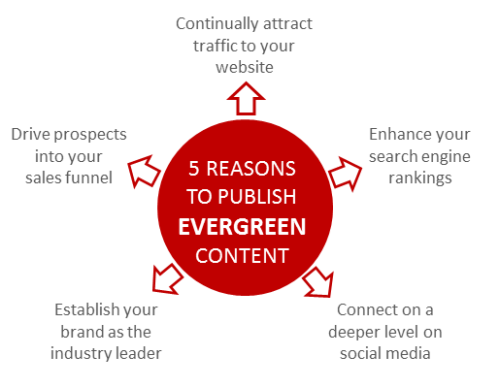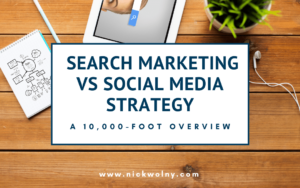Search marketing vs. Social media content strategy: a 10,000-foot overview

Do you wish your social media content strategy, which consists of content you spent valuable time and resources putting together, lasted longer?
You spend hours planning out your content for Facebook, Instagram, and LinkedIn, a few weeks later, everything has been posted and you’re back at zero. It can feel like a hamster wheel sometimes.
It helps to have pillar content that you can point back to when you want people to learn more about your particular area of expertise.
If you’re ready to
- Feel like it’s okay to step off the hamster wheel of content creation,
- Create content that stays relevant and never fades away, and
- Show off your expertise, authority, and smarts on autopilot,
You’re in the right place.
In this article, part 1 of my beginner’s guide on pillar content, we’ll get an overview of social media content strategy and search marketing from a 10,000-foot view.
We’ll also focus on why “pillar content” might be a magic throughline between the two worlds and integrate marketing for your business.
And to help with your pillar content process, I’ve created a “pillar content toolkit” of 5 FREE resources to help speed the process along, including a PDF copy of this entire guide. Cement what you learn and grab the toolkit here.
(Or grab it by clicking this link)
Search marketing strategy versus social media content strategy
Let’s first differentiate between the very sexy world of social media marketing and the slightly less-sexy world of search marketing.
If you have a social media content strategy, you’re probably trying to achieve one of three things:
- Building Brand Awareness and Connection – consumers hang out on social media platforms anyway, so you want to be there too and pop into their feed intermittently. Social media also became a revolution because it allows consumers to engage directly with the brands, businesses, and celebrities they love.
- Prove you’re legit – When a prospect first hears about your business or brand, one of the first things they may do is Google you to see where else you appear on the internet to determine if you’re legit.
- Become an influencer – love ‘em or hate ‘em, influencer marketing became a viable marketing channel in the 2010’s, and some people curate content solely to build followers on their platforms. Many purported influencers are phony, but many others are the real deal, and their audience sizes are an asset that can get them any speaking gig or book deal they want.
The challenge with social media marketing, however, is that most platforms use a scrolling feed structure that you have to keep depositing content into to use correctly.
Moreover, when you do drop pearls of wisdom, they disappear into the online noise quickly, and after weeks, months, or even years of posting, it can sometimes feel like you’re back at zero if you stop creating content.
Search based marketing, on the other hand, refers to you being the brand that shows up when someone has a problem and is searching for a solution.
The advantage to this content is that it is evergreen – meaning it lives on forever and can serve your business and inform people new to your business over and over again.

Blog articles, YouTube videos, and Pinterest images are search-based content; the content is already in place, and now the challenge is to get people in front of that content.
- Just moved to Omaha, Nebraska and want to buy a condo? You may search “Real Estate Agent In Nebraska”, and the realtor that shows up near the top of the search results is more likely to get the business.
- Want to soundproof a room in your home? “How to soundproof a room” will probably get you the answers you need. (I use this example more than once in this guide because yes, I am trying to soundproof a room in my house myself and have no clue what I’m doing! I found this guide through a Google search.)
- “How to meal prep on a budget” is pretty self-explanatory and lots of people want to know how to do it; if you find a piece of content that explains the whole process front-to-back, you’ll probably be more inclined to click on their in-article Amazon links for containers and cooking tools and recreate their process.
- And, oh, do you have an Etsy shop and want it to sell more stuff? My friend Jenny is the queen of this and her business Fuzzy & Birch helps shop owners achieve these exact results.
Many companies have built massive online footprints through smart, measured search marketing.
Social media content strategy and search marketing content strategy should blend together in some way. When they do, each helps the other, and you have a more cohesive and effective marketing approach as a result.

Your social media content strategy might be a waste of time
Pop quiz: What do you want your social media to do?
Are you there to grow your audience? Are you there to try and go viral? Do you yourself follow businesses and brands on social media?
If so, why or why not?
We spend so much time on these platforms that it can be easy to lose sight of our objectives.
Social media definitely passed blogging in the sexiness department over the last decade.
But when it comes to communicating authority and educating your readers, you need content that stays put in one spot so you can refer to it over and over again.

Our attention is more fractured than ever. If you have someone’s attention, would you rather serve them a quote box you found on some other website or give them content that will actually help them and make them rush to grab a pen and paper to excitedly take notes?
Social media is only the tip of the iceberg. If you really want to maximize your marketing strategy, a good approach may be to combine these promotional efforts with some search marketing content that can act as pillars for your business.
This pillar content is deeper, more detailed, and helpful. It builds authority and trust.

Never run out of ideas
Nothing is more painful than trying to post on social media regularly and feeling bone-dry on ideas or inspiration.
If coming up with new material every week feels hollow, it may be time to step back and create a standalone piece of content that has depth and that you can refer back to again and again.
Then your social media can act as an extension of that content. Figure out 20 ways to refer back to this standalone content, and voila, you have 20 new social media posts.
I like to call this “Pillar Content”.
What is Pillar Content?
In most cases, pillar content consists of a “long-form” blog post, usually in the range of 5,000-15,000-words.
It’s hosted on your own website, dives deep into a particular area of expertise, and it may be supplemented with images, infographics, audio, or video tutorials to help create a killer multimedia experience.
Pillar content makes readers drop everything they’re doing, read voraciously, take notes, and even bookmark the page for future reference. It also screams “expert” because amateurs simply can’t go deep on the topic or provide the insights that you can.
Pillar content can either be a single massively long post, or a series of posts that are linked together (such as this guide, for example).
Having your pillar content split up into multiple posts makes for multiple opportunities to show up in search results and has users spend more time on your site, which is a plus.
However, studies show that posts with 2,000 or more words get the most shares over the life of the content, but this is contingent on longer posts having enough quality to them to be engaging.
Only split up your posts if each one has enough meat on the bones to stand tall as its own post.

People are looking for quality content on the internet – in fact, it’s why there’s been a rise in paid subscription content from media outlets like the New York Times, Quartz, and the Harvard Business Review.
Here are some other examples of pillar content I personally love and have bookmarked:
- Want to lose weight or clean up your diet? Nerd Fitness does great posts that are authoritative, easy-to-follow, and very beginner friendly. (How friendly? Try “this is how you put chicken in an oven” friendly.) Here’s an example: “The Ultimate Skinny Guy’s Guide To Bulking Up Fast”.
- Thinking of moving to New York City? This massive guide from Curbed will give you everything you ever wanted and more. It’s actually a little hodge-podge for me, but clearly they know NYC quite well. I separately bookmarked this post within the guide on what boroughs to explore and how to budget before you take the plunge and relocate to the big apple.
- Want to convert more customers using psychology? Help desk app HelpScout crafted this brilliant piece of pillar content analyzing 10 psychological studies and relating them back to marketing. Graphs, charts, and images make this pillar content easy and exciting to read.
Why create pillar content to support social media content strategy?
When you’ve created pillar content once, you will always have it.
This is also true of a book. But to ask someone to read your whole book to get to know you better is a big ask.
Think of pillar content as a shorter, more compact version of a book that is easier to browse and easier to consume.
Pillar content can also be updated, expanded, and changed in real time. To update a book, you would have to re-release it or reposition it. That’s not the case with pillar content.
You know what else becomes a hundred times easier after you’ve created pillar content? Social media content strategy.
Imagine never running out of things to talk about, having your content be good and relevant every time, and having social media help drive web traffic in your business.
Lastly, pillar content helps Google and other search engines realize that you are an authority in your field.
A search engine wants to show its users quality content, so when you have a strong website, you are more likely to appear higher up in search results, which means more visibility, more clicks, more new subscribers, and more customers.
—
Hopefully by now you’re sold on the power of pillar content!
But how on earth do you go about getting started? And which content should you create first to help support your business in the best way possible?
To figure that out, go to the next section of this guide: Part 2: How to figure out what pillar content to create.

